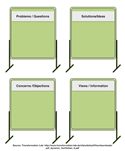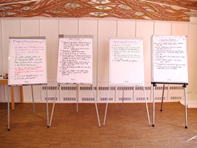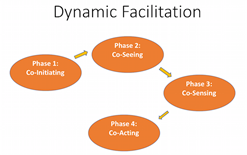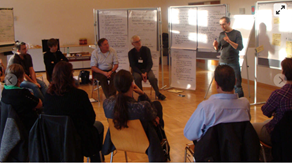Dynamic Facilitation
|
Field of application |
Facilitation and collaboration method for dealing with complex challenges, which can be used in workshops and research projects that includes a group of stakeholders. |
|
Resume / Brief description
|
A Dynamic Facilitation workshop starts with a certain topic on which every participant can give his or her opinion. No interruption is allowed as long as the person talks. The comments are written on cards or flipcharts along 4 panels and issues:
The facilitator takes the emotional element and the conflictive aspects out of the reflection round through differentiating and structuring the main arguments. Through this format every participant gets the chance to bring in their opinion and to listen to the other ones. The documentation and the process of listening provides at the end the opportunity to come up with joint solutions that are considering the different perspectives and arguments raised. |
|
Target group
|
|
| Group size
|
This format works especially with smaller and medium-sized groups of up to 15 people. |
|
Objectives |
The Dynamic Facilitation methodology has the objective to overcome classic facilitation methods often based on a very linear defined sequence. Different aspects are the following:
|
|
Requirements
|
The tool is suitable to use, when
Materials
Time
|
|
Implementation - Overview |
The activity is realised in four main phases.
|
|
Implementation - Guidelines
|
At the beginning of a Dynamic Facilitation process there is always an initial question or a problem that is relevant for the participants and for which no solution is yet in reach. Based on this question, the process of reflection starts considering four main phases.
1. Co-Initiating
2. Co-Seeing
3. Co-Sensing
4. Co-Acting
|
|
Example of application |
Reflection workshop with university and research institute representatives to increase local knowledge transfer with local businesses
Description of the context
Many universities and research institutes have the challenge to work together with local businesses. For many scientists it is more interesting to work with international research projects then to apply their knowledge to local business challenges. On the other side, these local businesses require new applied knowledge from the knowledge organisations in the surrounding. Many university staff members as well as consultancies that want to promote these local knowledge networks face the challenge to encourage local knowledge transfer projects due to very different opinions in the university or institute itself,. At the same time all employees and scientists know that they have to become involved in these projects if they want to get access to certain financial incentives.
Consultancies like Mesopartner often make use of the Dynamic Facilitation methodology in these situations with a group of representatives of local knowledge organisations. The objective of these Dynamic Facilitation workshops is to explore opportunities for concrete projects with local businesses and business organisations. Source: https://participedia.net/method/1692
Starting point
Identification of a topic: "How can we strengthen the knowledge transfer with local businesses in the region?"
Main discussion aspects
The discussion often includes controversial arguments although the conflict between participants is reduced. The reason is that everybody can express all their arguments, and nobody is allowed to interrupt the other. On this topic main discussion lines could be going into the following direction:
There are more arguments against or in favour of the local knowledge transfer focus. In the following, some answers along the four headings are documented:
Problems / Questions
Solutions / Ideas
Concerns / Objections
Perceptions / Information
The joint reflection with the staff members often changes at a certain point when all arguments and resentments are spoken out and structured. It often provides a breakthrough in which certain opportunities emerge. For example, the result can be that other research institutes are also interested to start with a contest for students and young researchers to find local knowledge transfer solutions through cross-innovation workshops within businesses.
In this case a solution could look like this:
The example above is just one example where the Dynamic Facilitation method can help to move from a relatively complex discussion of a topic towards a concrete result. An action plan format can finally help to define concrete next steps if the example of knowledge transfer contest or cross-innovation workshop approach should become realised.
Dynamic Facilitation requires much attention from the facilitator. Thus, it is good to get support from another facilitator who writes down on the cards while the leading facilitator moderates the process. Two facilitators would be good to be present. An alternative is to ask one of the participants to write on the cards or to document on flipcharts the main issues based on the directions from the lead facilitator. |
|
Templates, Graphics for download
|
The main features of the Dynamic Facilitation method can be found in the presentation Dynamic Facilitation.ppt
There are many graphics available in web search engines that visualise the main directions and logics of Dynamic Facilitation. Have a look at visualisation ideas for flipcharts at the Community of Practice website http://www.dynamicfacilitation.com/index.html
More information is available at:
|
|
Additional format/ references
|
Information on the method and step-by-step handouts:
Dynamic Facilitation Community of Practice page: http://www.dynamicfacilitation.com/index.html
The Dynamic Facilitation Method: https://participedia.net/method/1692
Online-Manual from the founder of the Dynamic Facilitation method, Jim Rough: http://www.co-intelligence.org/DFManual.html
A manual for Dynamic Facilitation and the Choice-Creating Process, by Rosa Zubizarreta and Jim Rough (2002), https://de.scribd.com/document/403917595/Dynamic-Facilitation-Manual
Videos:
Choice-creating and Dynamic Facilitation: https://www.youtube.com/watch?v=5Nc9lIXLB1s
Dynamic Facilitation – How it Works (by Jim Rough & Rosa Zubizarreta): https://www.youtube.com/watch?v=MpESecMWtfE |






No Comments